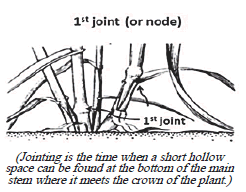

To send a message to an author, click on the author's name at the end of the article.
This Month in Ag Connection | Ag Connection - Other Issues Online
This year's winter wheat crop has had a rough start due to the extreme weather conditions. Early last autumn, conditions were extremely dry resulting in slow plant establishment. Then excessive rainfall during the late fall and early winter may have further impacted the crop. Saturated soils limit the supply of oxygen available to plant roots. The growing point of the winter wheat plant remains below ground until the plant begins to tiller. Prolonged lack of oxygen to the growing point and roots will cause plants to die. Greg Luce, MU Extension State Plant Science Specialist, says, "However, before writing off a winter wheat crop that has been flooded or ice covered, experience has taught me that wheat is very resilient." He recommends bringing a sample inside a warm building prior to green up and observing regrowth after a couple of days to determine if the stand should be kept for grain.
Autumn applied nitrogen may have been lost due to the extreme conditions. According to Peter Scharf, MU Extension State Soil Fertility Specialist, the ideal time to apply nitrogen fertilizer to winter wheat is just before jointing. Wheat plants take up most of their nitrogen once they are actively growing in April and May. Applying fertilizer early in the season allows more time for nitrogen loss from the soil to occur.

Two years of data from a project conducted by Scharf in Columbia resulted in a 10 bushel per acre yield increase when nitrogen was applied to winter wheat in mid-March versus mid-February. Sixteen years of research projects resulted in a 6.8 bushel per acre increase in yield when nitrogen was applied in March over those where nitrogen was applied in February. On average, the optimum nitrogen fertilizer rate in all of Scharf's studies was 79 pounds of nitrogen per acre resulting in 67 bushel per acre yield.
Scharf recommends using polymer coated urea as the nitrogen source if applied prior to mid-March. This coating slows the release of the fertilizer. The one time Scharf recommends applying nitrogen at greenup rather than in mid-March is to promote tillering. Plants with less than two good tillers per plant would benefit from a nitrogen application at greenup. Polymer coated urea should not be used in this situation.
Monitor winter wheat fields for weed, insect and disease pressure throughout the growing season. For more information contact a MU Extension regional agronomy specialist.
Source: Valerie Tate, Agronomy Specialist
This Month in Ag Connection | Ag Connection - Other Issues Online
The Northeast Missouri Show-Me-Select Replacement heifer sale averaged $2,394 at F & T Livestock Auction in Palmyra on December 12.
The 20 producers of the 319 heifers were enrolled in the MU educational heifer management program. The heifers were bred to sires with both calving-ease and growth genetics. The top lot sold belonged to Kris and Tracy Graupman and brought $3,700.
Highest average price from a consignor was $3,200 on 15 head from Richards Farms of Keytesville. Other top consignors were Kris and Tracy Graupman of Palmyra, $2,990 on 10 head; Prairie View Farms of Monroe City, $2,933 on 24 head; Keithley/Jackson of Frankford, $2,693 on 14 head, and Gene and Kim Dryden of Hannibal, $2,600 on 3 head.
The 39 buyers were responsible for over $750,000 worth of bred heifers exchanging hands in less than two hours. Twenty-five repeat buyers purchased 159 head, or 50 percent of the total consignment. Calving surveys returned by these buyers provide important information back to consignors to improve for future years.

The Show-Me-Select heifer development program takes nearly a year to complete. The heifers complete a pre-breeding examination usually 4 to 8 weeks before breeding. The exam includes a pelvic measurement, reproductive tract score, and weight. Heifers may be bred artificially or be exposed to natural service, however; service sires must meet specific calving ease EPD requirements based on breed. This year 225 head, or 71 percent, of heifers in the sale were synchronized and bred AI. The choice of AI bred heifers showed a $299 price advantage over those bred naturally.
All heifers must be pregnancy tested within 90 days of breeding by a veterinarian to determine expected calving date. During the development period, the heifers undergo an extensive health program and are vaccinated at weaning, pre-breeding, and pregnancy examination, as well as, treated several times for internal and external parasites. Heifers are also screened for blemishes, condition, muscling and structural soundness by MU Extension livestock specialists and USDA graders.
Averages of other Show-Me-Select sales from fall 2015 were Joplin, $2,477 on 293 head; Kirksville, $2,386 on 195 head; Kingsville, $2,311 on 216 head; and Fruitland, $2,374 on 133 head.
This was the 19th year for the Show-Me-Select Heifer sale in Palmyra. A total of 33,149 heifers have been through the program with 5,448 head being sold. There were several new consignors this year and more expected to start next year. If interested, contact your local MU Extension livestock specialist.
Source: Daniel Mallory, Regional Livestock Specialist
This Month in Ag Connection | Ag Connection - Other Issues Online
This article will discuss two strategies for achieving maximum farm machinery life. These strategies are: machinery maintenance and engine tune-ups.
Machinery Maintenance
A Midwest study showed that many farmers could reduce machinery repair costs 25 percent by improving routine maintenance procedures. With a yard full of machinery, that savings can be significant. As an example, an $80,000 tractor will typically require about $24,000 in repair costs during 5,000 hours of operation when receiving average maintenance. This cost can be decreased to approximately $18,000 by increasing the level of service management. Some ideas for improving maintenance procedures are as follows.
Timely preventative maintenance and inspection will not only help reduce major problems and downtime, it will also help identify problems when they can be corrected with relatively minor repairs.
Equipment repaired during the winter can save money on service at mechanics' shops. An effective machinery service program requires good record keeping. It should not be based on the operator's feelings or memory as to when a machine needs attention.
The maintenance program must be based on fact as determined by an accurate service record for each piece of equipment as recommended by the operator's manual and adjusted to individual conditions.
Engine Tune-Ups

Diesel and gas engines require periodic tune-ups. As engines operate, they lose power and fuel efficiency. To obtain the optimum performance from an engine, the power produced and the fuel consumed should be checked and compared to the University of Nebraska Tractor Test data. Test reports can be obtained from the Nebraska Tractor Testing Laboratory at http://tractortestlab.unl.edu/
Test results include several ratings for each tractor. For comparative purposes, look at the figures that indicate tractor PTO horsepower and specific fuel consumption at maximum PTO horsepower. The next step is to test the tractor. The tractor should be tested on a certified PTO dynamometer found at most equipment dealers. Attach the tractor's power take-off to a dynamometer, warm the engine up and check to see if it produces rated PTO horsepower. If tractor power is down by more than 5 percent, adjustments or a tune-up is needed. A tune-up may include changing air and fuel filters, cleaning and adjusting injector nozzles, and adjusting engine timing.
Another important part of tractor operation is checking fuel efficiency. This can be done at the time the tractor is operating on the PTO dynamometer. After the tractor is warmed to operating temperatures, stop the tractor and fill the fuel tank completely full. Operate the tractor at rated speed and load for 30 minutes (longer for more accurate results), then stop the tractor and refill the tank to the previous level, keeping track of the gallons. Fuel efficiency will give an idea of the engine's condition.
Specific fuel consumption or fuel economy is measured in horsepower-hours per gallon (hp-hr/gal), much as automobile fuel efficiency is measured in miles per gallon. To calculate the efficiency of the tractor, first determine the gallons of fuel used in one hour. For example, a diesel tractor producing 155 hp and using 5.5 gallons in 30 minutes would use 11 gallons in an hour. Divide the 155 horsepower by 11 gal/hr, which gives a fuel efficiency of 14 hp-hr/gal.
Compare this figure to University of Nebraska Tractor Test data during the PTO tests at rated horsepower. If the current efficiency is 5 to 10 percent less than original, there may be a problem that needs correction. If an engine is showing a 5 percent reduction in fuel efficiency, it is wasting about 5 percent of the fuel. In a 155 horsepower tractor burning 11 gal/hr, this adds up to 0.55 gallons of fuel wasted every hour or 275 gallons wasted every 500 hours of use.
Summary
No single item will have a large effect, but a combination of practices can have a large impact on costs, improve machine reliability for many years to come, and improve profit margins.
The information for this article was obtained from a guide sheet available from Virginia Tech entitled Five Strategies for Extending Machinery Life, http://www.ext.vt.edu/pubs/bse/442-451/442-451.html
Source: Kent Shannon, Natural Resource Engineering Specialist
This Month in Ag Connection | Ag Connection - Other Issues Online
Missouri's fence and boundary laws continue to raise questions from landowners throughout the state. The following will discuss some common questions related to fences and boundaries.

Missouri's fence law is very complicated and can be confusing. It is critical to know the county's fence law. University of Missouri Extension has two guides on the law, guide 811 Missouri's Fencing and Boundary Laws: Frequently Asked Questions (http://extension.missouri.edu/p/G811) and guide 810 Missouri's Fencing and Boundary Laws (http://extension.missouri.edu/p/G810). Joe Koenen can be contacted for specific questions at 660) 947-2705 or email koenenj@missouri.edu
Source: Joe Koenen, Ag Business Specialist
Publishing Information
Ag Connection is published monthly for Northeast and Central areas of Missouri producers and is supported by the University of Missouri Extension, the Missouri Agricultural Experiment Station, and the MU College of Agriculture, Food and Natural Resources. Managing Editor: Mary Sobba.